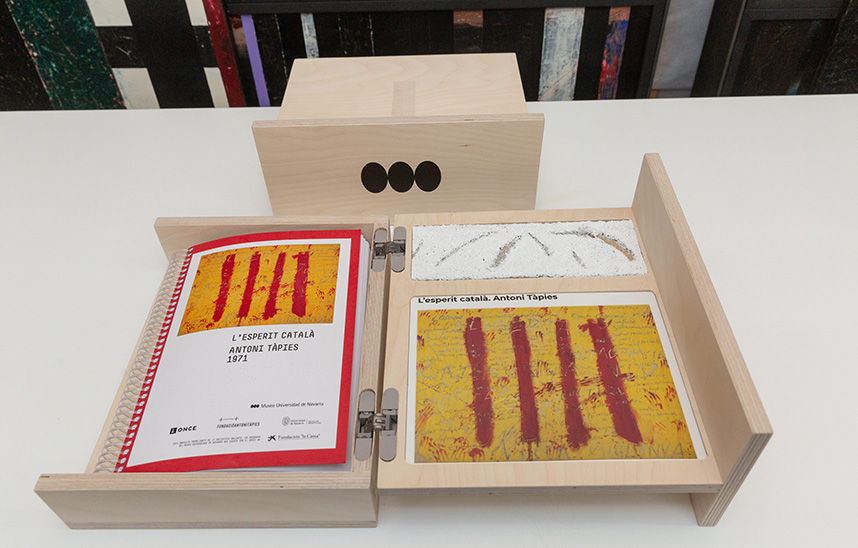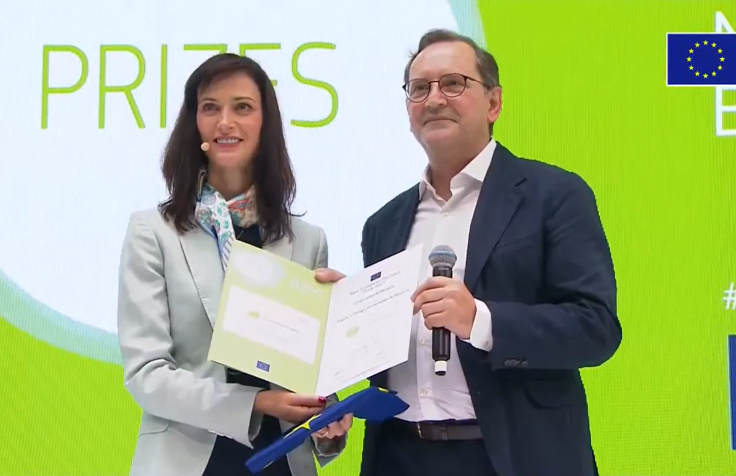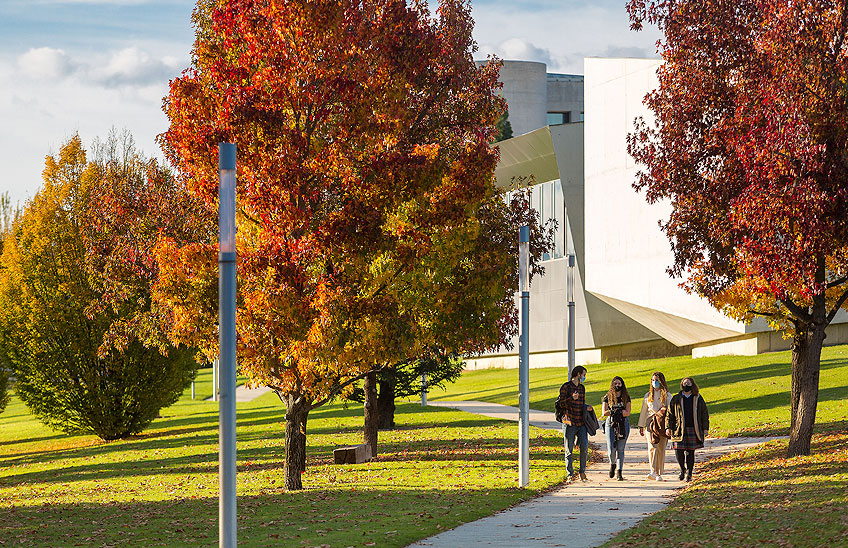Fundació Antoni Tàpies, group ONCE, Fundació "La Caixa" and the MUN present 'El maletín de Tàpies', a project that facilitates the artistic experience for visually impaired people.
The briefcase, which has counted with the partnership of the School of Architecture of the University of Navarra and the support of 'la Caixa' Foundation, contains a set of sensory mediation tools designed to bring to this group the work 'L'esperit català' (1971), by Antoni Tàpies, belonging to the collection MUN.

The proposal is part of the Museum's project SociARTE, an initiative that places the Museum's resources at the service of social organizations and in which 25 groups currently participate.
How can blind or visually impaired people have an experience with a pictorial work of contemporary art? The Fundació Antoni Tàpies, ONCE and the Museo Universidad de Navarra, at partnership with the School of Architecture of the University of Navarra and with the support of Fundación 'la Caixa', have joined forces and creativity to promote this artistic experience. The result is The Tàpies briefcasea set of sensory mediation tools designed to bring this group closer to the work L'esperit català (1971), by Antoni Tàpies. The piece belongs to the Museo Museo Universidad de Navarra Collection, thanks to the bequest of collector María Josefa Huarte, and will participate in the exhibition that the Museo Nacional Centro de Arte Reina Sofía is preparing for the centenary of the artist's birth. Tàpies' briefcase will also travel to Madrid.
In the presentation of this Friday in Pamplona have participated Imma Prieto, director of the Fundació Antoni Tàpies; Valentín Fortún, territorial delegate of Navarra of the ONCE; Izaskun Azcona, delegate of "la Caixa" Foundation in Navarra; MªAngélica Martínez, professor of the School of Architecture of the University of Navarra; and Jaime García del Barrio, director general of the MUN. The proposal is part of the MUN's project SociARTE , an initiative that seeks to put the Museum's resources and tools at the service of social organizations. Currently, 25 groups are members.
A briefcase full of possibilities
Fernando Echarri, manager of the Museum's educational area and the SociARTE program, explains the origin of project: "ONCE is part of SociARTE and one of its needs was to bring contemporary art closer to the visually impaired. Among the different possibilities, we decided to work on Antoni Tàpies ' L'esperit catalá, taking advantage of the centenary of his birth (1923)". In this sense, he values that "the MUN is a young museum that is learning to walk in an inclusive way, establishing networks with different people and groups. For this reason, this experience is considered a pioneer in the intention of creating inclusive materials that allow interaction with contemporary art and mediation between art and different people. The work with these entities has result very rewarding and profitable, an opportunity that we will not forget".
Thus, with the help of partnership of all the institutions involved, this unique briefcase was designed, as described by Echarri: "It is made up of three sections: the first consists of a notebook in Braille and Spanish that contains information on the artist's biography, his pictorial keys, the work and the transcription of the written contents of the piece. The booklet also has QR codes that give access to the respective audio guides of these contents. The second section has a reproduction of the work, highlighting its most significant words in Braille. The third section contains a board with a texture similar to that of the work so that it can be touched. In this way, these people can approach Tàpies' work with other senses beyond sight".
For her part, MªAngélica Martínez, professor at the School of Architecture of the University of Navarra, explains the participation of five students from the Degrees in design and Architecture, who were asked to create an art book for people with total blindness from birth, acquired blindness or visual weakness (residual vision). "The book proposal is result of the documentation and research of the students, of the ideation and the evaluation of a series of concepts, through the analysis of the tests and the reaction of the users, of the development of the design, considering the aesthetics of the objects and sculptures of Antoni Tàpies, as well as the real options offered by the different institutions and companies involved."
Thanks to this project, notes the professor, they have also been able to reflect on issues such as "the perception of the work of art through touch and hearing; the recreation of the context of the 70s and the fundamental inspiration of Tàpies; and the interpretation of art through the recreation of matter painting, poor art and graffiti".
Rosa Eva Campo and Maria Sellarès, from area of Education of the Fundació Antoni Tàpies, emphasize that "L'esperit català" ( 1971) is a material work, very representative of the artist's painting. And the tactile reproduction facilitates the understanding of the technique and materials used by Tàpies. In this case, he used a mixture of varnish and marble dust, covered with paint, very characteristic of the artist's so-called 'materials'. In addition, the material includes the inscriptions that Tàpies made on this work in Braille. Thus, the Username will have specific information about the work, texts in Braille about the context and the artist's biography, which will undoubtedly enhance the experience of the visually impaired public".
From ONCE, Valentín Fortún, delegate in Navarra, values very positively the project: "It is a good internship in terms of universal accessibility that allows people with severe visual impairment to access, in this case, the work of Tàpies. In addition, it is a wake-up call for the normalization that an inclusive society must incorporate in order to include the diversity that makes it up".
For Izaskun Azcona, delegate of "la Caixa" Foundation in Navarra, "strategic alliances like the one we have with the MUN, through its SociARTE program, help us to consolidate our support for art and culture as source of development staff and social. At the end of the day, what we seek is to generate a fairer society that leaves no one behind, on this occasion with the language of contemporary art and its strategies".
He also highlights "the good technical coordination between the institutions involved, which has given as result this project accessibility; and, on the other hand, the sensitivity and empathy with the group of people with total blindness and severe visual impairment, which has had both the University Museum of Navarra and the Fundació Tàpies".




